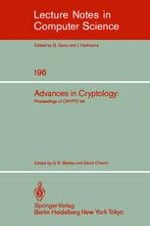1985 | OriginalPaper | Buchkapitel
Authentication Theory/Coding Theory
verfasst von : Gustavus J. Simmons
Erschienen in: Advances in Cryptology
Verlag: Springer Berlin Heidelberg
Enthalten in: Professional Book Archive
Aktivieren Sie unsere intelligente Suche, um passende Fachinhalte oder Patente zu finden.
Wählen Sie Textabschnitte aus um mit Künstlicher Intelligenz passenden Patente zu finden. powered by
Markieren Sie Textabschnitte, um KI-gestützt weitere passende Inhalte zu finden. powered by
We consider a communications scenario in which a transmitter attempts to inform a remote receiver of the state of a source by sending messages through an imperfect communications channel. There are two fundamentally different ways in which the receiver can end up being misinformed. The channel may be noisy so that symbols in the transmitted message can be received in error, or the channel may be under the control of an opponent who can either deliberately modify legitimate messages or else introduce fraudulent ones to deceive the receiver, i.e., what Wyner has called an “active wiretapper” [1]. The device by which the receiver improves his chances Of detecting error (deception) is the same in either case: the deliberate introduction of redundant information into the transmitted message. The way in which this redundant information is introduced and used, though, is diametrically opposite in the two cases.
